 ผศ.ดร.ละมัย ร่มเย็น
ผศ.ดร.ละมัย ร่มเย็น
สาขาวิชารัฐประศาสนศาสตร์ มหาวิทยาลัยราชภัฏสกลนคร E-mail: lamairomyen@gmail.com
รป.ด. (รัฐประศาสนศาสตร์)
ศศ.ม. (บรรณารักษศาสตร์และสารนิเทศศาสตร์)
ค.บ. (บรรณารักษศาสตร์)
คำแนะนำสำหรับผู้นิพนธ์
วารสารวิทยาการบริหารภาครัฐสมัยใหม่
ขั้นตอนการส่งบทความ
1. การเตรียมบทความ ก่อนส่งบทความเพื่อขอตีพิมพ์ ผู้นิพนธ์ควรศึกษาและปฏิบัติตามคำแนะนำดังต่อไปนี้อย่างละเอียด
1.1 ตรวจสอบความเหมาะสมของเนื้อหา
1.2 เลือกประเภทบทความ วารสารรับพิจารณา 2 ประเภท:
2.1 ลงทะเบียนในระบบ
2.2 เข้าสู่ระบบและส่งบทความ
2.3 เอกสารที่ต้องอัพโหลด
รูปแบบการเขียนบทความ
3.1 รูปแบบทั่วไป
กระดาษและระยะขอบ
ฟอนต์และระยะห่าง
ความยาวบทความ
3.2 โครงสร้างบทความวิจัย
บทความวิจัยต้องมีเนื้อหาไม่เกิน 15 หน้ากระดาษ A4 มีองค์ประกอบหลักดังนี้
ตัวอย่างการเขียนองค์ความรู้
การวิจัยนี้ได้สร้างองค์ความรู้ใหม่เกี่ยวกับการพัฒนาธรรมาภิบาล
ในองค์กรปกครองส่วนท้องถิ่น โดยพบว่า...
จากการวิจัย ผู้วิจัยได้พัฒนา "โมเดลธรรมาภิบาลท้องถิ่นแบบมีส่วน
ร่วม" ซึ่งประกอบด้วย 5 องค์ประกอบหลัก คือ...
[รูปภาพแสดงโมเดล]
โมเดลนี้สามารถนำไปประยุกต์ใช้ในการพัฒนา อปท. ทั้งในระดับ
นโยบายและการปฏิบัติ โดยเฉพาะใน...
การวิจัยนี้ยังได้เสริมทฤษฎี... โดยขยายความเข้าใจเกี่ยวกับ... และ
เติมเต็มช่องว่างทางวิชาการใน..
3.3 โครงสร้างบทความวิชาการ
บทความวิชาการมีความยืดหยุ่นมากกว่าบทความวิจัย แต่ควรประกอบด้วย
เอกสารอ้างอิง (ขนาด 14pt ชนิดตัวหนา จัดกึ่งกลาง)
(รายการอ้างอิง ขนาด 14pt ชนิดตัวธรรมดา เรียงลำดับตามตัวอักษร และจำนวนรายการต้องตรงกันและเท่ากันกับที่ใช้อ้างอิงในเนื้อหาบทความ) โดยเขียนเอกสารอ้างอิง (Reference List) ตามรูปแบบ APA 7th Edition (American Psychological Association, 7th Edition) ซึ่งเป็นรูปแบบมาตรฐานที่ใช้กันอย่างแพร่หลายในงานวิจัยและบทความทางวิชาการ รายละเอียดดังนี้
หลักทั่วไปของการจัดเรียงรายการอ้างอิงตามรูปแบบ APA 7th
ตัวอย่างการจัดเรียง (ภาษาไทยก่อน ภาษาอังกฤษ)
🔸 ภาษาไทย
กาญจนา แก้วเทพ. (2561). การสื่อสารกับการพัฒนาอย่างยั่งยืน. กรุงเทพฯ: สำนักพิมพ์มหาวิทยาลัยธรรมศาสตร์.
ขจรศักดิ์ ศรีพนา. (2563). ภาวะผู้นำเชิงกลยุทธ์ในองค์กรภาครัฐ. นครราชสีมา: มหาวิทยาลัยเทคโนโลยีราชมงคลอีสาน.
ชูชาติ ศรีภูมิ. (2560). การบริหารงานภาครัฐแนวใหม่. กรุงเทพฯ: สำนักพิมพ์จุฬาลงกรณ์มหาวิทยาลัย.
พัชรี วัฒนวิจิตร์. (2562). ธรรมาภิบาลในองค์กรปกครองส่วนท้องถิ่น. เชียงใหม่: มหาวิทยาลัยเชียงใหม่.
เรียงลำดับ: ก → ข → ช → พ
🔹 ภาษาอังกฤษ
Anderson, J. (2020). Public administration and organizational behavior. New York, NY: Routledge.
Brown, T., & Kelly, M. (2018). Strategic leadership for sustainable governance. London: Sage.
Carter, L. (2021). Innovation in local government. Oxford: Oxford University Press.
Davis, R. (2019). Transparency and accountability in public organizations. Cambridge: Cambridge University Press.
เรียงลำดับ: A → B → C → D
ข้อควรระวัง
พยัญชนะภาษาไทย (Thai Alphabet Order)
ใช้ลำดับเดียวกับพจนานุกรมไทยหรือราชบัณฑิตยสถาน ดังนี้:
ก ข ฃ ค ฅ ฆ ง จ ฉ ช ซ ฌ ญ ฎ ฏ ฐ ฑ ฒ ณ ด ต ถ ท ธ น บ ป ผ ฝ พ ฟ ภ ม ย ร ล ว ศ ษ ส ห ฬ อ ฮ
หมายเหตุ :
ตัวอักษรภาษาอังกฤษ (English Alphabet Order)
ใช้ลำดับตัวอักษรภาษาอังกฤษมาตรฐาน 26 ตัว ดังนี้:
A B C D E F G H I J K L M N O P Q R S T U V W X Y Z
หมายเหตุ :
การเขียนเอกสารอ้างอิงแบบ APA 7th Edition สำหรับ “หนังสือออนไลน์ (E-Book)” และ “บทความวารสารออนไลน์ (Online Journal Article)”
📘 1. หนังสือออนไลน์ (E-Book)
🔹 รูปแบบ (ภาษาไทย)
ผู้แต่ง. (ปี). ชื่อหนังสือ. เมืองที่พิมพ์: สำนักพิมพ์. เข้าถึงจาก URL
ตัวอย่าง:
กาญจนา แก้วเทพ. (2565). การสื่อสารกับการพัฒนาอย่างยั่งยืน. กรุงเทพฯ: สำนักพิมพ์มหาวิทยาลัยธรรมศาสตร์. เข้าถึงจาก https://ebook.tu.ac.th/sustainability
คำอธิบาย:
🔹 รูปแบบ (ภาษาอังกฤษ)
Author, A. A. (Year). Title of the book. Publisher. URL
ตัวอย่าง:
Northouse, P. G. (2021). Leadership: Theory and practice (8th ed.). Sage Publications. https://books.google.com/books?id=leadership8
คำอธิบาย:
📖 2. บทความวารสารออนไลน์ (Online Journal Article)
🔹 รูปแบบ (ภาษาไทย)
ผู้แต่ง. (ปี). ชื่อบทความ. ชื่อวารสาร, ปีที่(ฉบับที่), หน้าที่. เข้าถึงจาก URL
ตัวอย่าง:
ขจรศักดิ์ ศรีพนา. (2566). การพัฒนาภาวะผู้นำเชิงกลยุทธ์ของผู้บริหารท้องถิ่น. วารสารรัฐประศาสนศาสตร์และการพัฒนา, 15(2), 45–60. เข้าถึงจาก https://so08.tci-thaijo.org/index.php/jpda
คำอธิบาย:
🔹 รูปแบบ (ภาษาอังกฤษ)
Author, A. A. (Year). Title of the article. Journal Name, volume(issue), page range. https://doi.org/xxxx
ตัวอย่าง 1 (มี DOI):
Northouse, P. G. (2020). Leadership development in public organizations. Public Administration Review, 80(4), 678–690. https://doi.org/10.1111/puar.13156
ตัวอย่าง 2 (ไม่มี DOI แต่มี URL):
Anderson, J. (2022). Strategic innovation in local governance. Journal of Public Management, 18(1), 25–40. https://journalofpublicmanagement.org/articles/2022
คำอธิบาย:
🧾 3. ตัวอย่างรวม (References Section)
เอกสารอ้างอิง
กาญจนา แก้วเทพ. (2565). การสื่อสารกับการพัฒนาอย่างยั่งยืน. กรุงเทพฯ: สำนักพิมพ์มหาวิทยาลัยธรรมศาสตร์. เข้าถึงจาก https://ebook.tu.ac.th/sustainability
ขจรศักดิ์ ศรีพนา. (2566). การพัฒนาภาวะผู้นำเชิงกลยุทธ์ของผู้บริหารท้องถิ่น. วารสารรัฐประศาสนศาสตร์และการพัฒนา, 15(2), 45–60. เข้าถึงจาก https://so08.tci-thaijo.org/index.php/jpda
Anderson, J. (2022). Strategic innovation in local governance. Journal of Public Management, 18(1), 25–40. https://journalofpublicmanagement.org/articles/2022
Northouse, P. G. (2021). Leadership: Theory and practice (8th ed.). Sage Publications. https://books.google.com/books?id=leadership8
Northouse, P. G. (2020). Leadership development in public organizations. Public Administration Review, 80(4), 678–690. https://doi.org/10.1111/puar.13156
หมายเหตุ: การเขียนแบบออนไลน์ (APA 7th)
การเขียนการอ้างอิงแทรกในเนื้อหา (In-text citation)” ตามรูปแบบ APA 7th Edition
การอ้างอิงในเนื้อหาแบบ APA 7th ใช้หลักการ (ผู้แต่ง, ปี) เพื่อเชื่อมโยงกับรายการ “เอกสารอ้างอิง” (Reference list) ที่อยู่ท้ายเล่ม/บทความมีอยู่ 2 รูปแบบหลักคือ
รูปแบบการอ้างอิงแทรกตามจำนวนผู้แต่ง
🔹 (1) ผู้แต่งคนเดียว
ตัวอย่าง (ภาษาไทย):
ตัวอย่าง (ภาษาอังกฤษ):
🔹 (2) ผู้แต่งสองคน
ตัวอย่าง (ภาษาไทย):
ตัวอย่าง (ภาษาอังกฤษ):
🔹 (3) ผู้แต่งสามคนขึ้นไป
ตัวอย่าง (ภาษาไทย):
ตัวอย่าง (ภาษาอังกฤษ):
🔹 (4) องค์กรหรือหน่วยงานเป็นผู้แต่ง
ตัวอย่าง (ภาษาไทย):
ตัวอย่าง (ภาษาอังกฤษ):
🔹 (5) ไม่มีชื่อผู้แต่ง (ใช้ชื่อเรื่องแทน)
🧾 3. ตัวอย่างการใช้ในย่อหน้าจริง
🔸 ตัวอย่าง (ภาษาไทย)
การบริหารจัดการภาครัฐแนวใหม่เน้นความโปร่งใสและการมีส่วนร่วมของประชาชน (ขจรศักดิ์ ศรีพนา, 2566) ซึ่งสอดคล้องกับแนวคิดของสำนักงานคณะกรรมการพัฒนาระบบราชการ (ก.พ.ร., 2566) ที่เน้นธรรมาภิบาลและการบริหารกิจการบ้านเมืองที่ดี นอกจากนี้ กาญจนา แก้วเทพ (2565) ยังชี้ให้เห็นว่า การสื่อสารที่มีประสิทธิภาพช่วยสร้างความเชื่อมั่นระหว่างรัฐและประชาชนได้อย่างยั่งยืน
🔸 ตัวอย่าง (ภาษาอังกฤษ)
Leadership plays a vital role in promoting transparency in public administration (Northouse, 2020). According to Robbins and Coulter (2021), effective management practices enhance employee motivation and organizational success. Similarly, the World Health Organization (WHO, 2023) emphasized the importance of participatory governance in improving public services.
หมายเหตุ: เคล็ดลับสำคัญ
- ปี ค.ศ./พ.ศ. ต้องตรงกับใน “เอกสารอ้างอิงท้ายบท”
- ชื่อผู้แต่งใช้เฉพาะ “นามสกุล” (surname) เท่านั้น
- ไม่ใช้เลขเชิงอรรถ (footnote) แทนการอ้างอิง
- ถ้าอ้างหลายแหล่งในวงเล็บเดียวกัน ให้เรียงตามลำดับตัวอักษร และใช้ “;” คั่น
- ควรใช้เอกสารอ้างอิงที่ทันสมัยและน่าเชื่อถือ กล่าวคือ แหล่งข้อมูลที่ผู้เขียนบทความนำมาใช้อ้างอิงหรือประกอบการเขียน โดยต้องมีคุณลักษณะดังนี้
การตั้งค่าหน้ากระดาษ
ให้ใช้รูปแบบอักษรและการจัดวางตำแหน่ง ดังนี้
- พิมพ์บนกระดาษขาว A4 หน้าเดียว (หรือ 8.5 นิ้ว x 11 นิ้ว) พิมพ์แบบเสมอหน้า-หลัง (Justified) ด้วยโปรแกรม MS-Word
- ตั้งค่าหน้ากระดาษ ดังนี้
บน 1.50 นิ้ว ล่าง 1.00 นิ้ว
ซ้าย 1.00 นิ้ว ขวา 1.00 นิ้ว
5.1 ตาราง (Tables)
รูปแบบ:
ตัวอย่าง:
ตารางที่ 1 ระดับความพึงพอใจของประชาชนต่อการบริการสาธารณะ
รายการ ค่าเฉลี่ย S.D.
การบริการด้านสาธารณสุข 4.25 0.68
การบริการด้านการศึกษา 4.10 0.72
การบริการด้านสาธารณูปโภค 3.95 0.81
หมายเหตุ: คะแนนเต็ม 5
5.2 รูปภาพและแผนภูมิ (Figures)
รูปแบบ:
ตัวอย่าง:
[รูปภาพ/แผนภูมิ]
รูปที่ 1 กรอบแนวคิดการวิจัย
ที่มา: ผู้วิจัย, 2566
6.1 สำหรับผู้นิพนธ์
ความเป็นต้นฉบับ (Originality)
การลอกเลียนผลงาน (Plagiarism)
การเป็นผู้นิพนธ์ (Authorship)
ผลประโยชน์ทับซ้อน (Conflict of Interest)
จริยธรรมการวิจัย (Research Ethics)
6.2 สำหรับกองบรรณาธิการ
6.3 สำหรับผู้ทรงคุณวุฒิ
7.1 ขั้นตอนการพิจารณา
ขั้นตอนที่ 1: การตรวจสอบเบื้องต้น (1 สัปดาห์)
ขั้นตอนที่ 2: การพิจารณาโดยผู้ทรงคุณวุฒิ (4-6 สัปดาห์)
ขั้นตอนที่ 3: การแจ้งผลและแก้ไข (1-2 สัปดาห์)
ขั้นตอนที่ 4: การตรวจสอบและจัดพิมพ์ (2-3 สัปดาห์)
7.2 ผลการพิจารณา
บทความอาจได้รับผลการพิจารณา 5 ประเภท:
8.1 ค่าธรรมเนียมการตีพิมพ์
อัตราค่าธรรมเนียม: 3,000 บาทต่อ 1 บทความ
การชำระเงิน:
หมายเหตุ:
8.2 ลิขสิทธิ์
การโอนลิขสิทธิ์:
การนำบทความไปใช้:
9.1 การสอบถามข้อมูล
ก่อนส่งบทความ:
หลังส่งบทความ:
9.2 ระยะเวลาการติดต่อกลับ
Q1: บทความต้องผ่านการตรวจสอบการลอกเลียนผลงานก่อนส่งหรือไม่?
A: แนะนำให้ตรวจสอบก่อนส่ง แต่วารสารจะตรวจสอบอีกครั้งด้วยโปรแกรม Turnitin ความซ้ำซ้อนต้องไม่เกิน 25%
Q2: ส่งบทความที่เป็นส่วนหนึ่งของวิทยานิพนธ์ได้หรือไม่?
A: ได้ แต่ต้องปรับปรุงให้อยู่ในรูปแบบบทความวิจัย และระบุในกิตติกรรมประกาศว่าเป็นส่วนหนึ่งของวิทยานิพนธ์
Q3: ส่งบทความที่นำเสนอในการประชุมวิชาการแล้วได้หรือไม่?
A: ได้ หากไม่ได้ตีพิมพ์ในรายงานสืบเนื่องจากการประชุม (Proceedings) หรือหากได้รับอนุญาตจากผู้จัดการประชุม
Q4: ใช้เวลานานเท่าไรตั้งแต่ส่งบทความจนตีพิมพ์?
A: โดยเฉลี่ย 2-3 เดือน ขึ้นอยู่กับคุณภาพบทความและความรวดเร็วในการแก้ไข
Q5: สามารถถอนบทความหลังส่งแล้วได้หรือไม่?
A: ได้ ก่อนส่งผู้ทรงคุณวุฒิพิจารณา หากส่งผู้ทรงคุณวุฒิแล้วจะไม่สามารถถอนได้
Q6: ผู้นิพนธ์ต้องเป็นสมาชิกของวารสารหรือไม่?
A: ไม่จำเป็น แต่ต้องลงทะเบียนในระบบเพื่อส่งบทความ
Q7: วารสารรับบทความภาษาอังกฤษทั้งหมดได้หรือไม่?
A: ได้ และสนับสนุนเพื่อเพิ่มการเผยแพร่สู่ระดับนานาชาติ
Q8: หากผู้ทรงคุณวุฒิให้ความเห็นแตกต่างกัน จะตัดสินอย่างไร?
A: กองบรรณาธิการจะพิจารณาจากความเห็นของผู้ทรงคุณวุฒิทั้ง 3 ท่าน และอาจขอความเห็นเพิ่มเติมหรือตัดสินด้วยดุลยพินิจ
ผู้นิพนธ์สามารถดาวน์โหลดเอกสารที่จำเป็นได้จากเว็บไซต์วารสาร:
✓ แบบฟอร์มบทความ (Article Template) - ภาษาไทยและภาษาอังกฤษ
✓ แบบฟอร์มตรวจสอบบทความ (Submission Checklist)
✓ แบบฟอร์มโอนลิขสิทธิ์ (Copyright Transfer Form)
✓ คู่มือการใช้ APA 7th Edition
✓ ตัวอย่างบทความที่ตีพิมพ์
สำนักงานบรรณาธิการ
หลักสูตรรัฐประศาสนศาสตรดุษฎีบัณฑิต
คณะวิทยาการจัดการ มหาวิทยาลัยราชภัฏสกลนคร
680 หมู่ 11 ถนนนิตโย ตำบลธาตุเชิงชุม
อำเภอเมืองสกลนคร จังหวัดสกลนคร 47000
ช่องทางการติดต่อ:
วารสารวิทยาการบริหารภาครัฐสมัยใหม่
"เพื่อการบริหารภาครัฐที่ดี ทันสมัย และยั่งยืน"
"For Good, Modern, and Sustainable Public Administration"
 ผศ.ดร.ละมัย ร่มเย็น
ผศ.ดร.ละมัย ร่มเย็น
สาขาวิชารัฐประศาสนศาสตร์ มหาวิทยาลัยราชภัฏสกลนคร E-mail: lamairomyen@gmail.com
รป.ด. (รัฐประศาสนศาสตร์)
ศศ.ม. (บรรณารักษศาสตร์และสารนิเทศศาสตร์)
ค.บ. (บรรณารักษศาสตร์)
01 คำแนะนำในการเตรียมต้นฉบับบทความ
02 วิธีการลงทะเบียนสมาชิกในเว็บไซต์ของวารสาร
03 วิธีการส่งบทความในระบบของวารสาร
04 วิธีการชำระค่าดำเนินการ (APC)



Department of Public Administration, Faculity of Management Science, Sakon Nakhon Rajabhat University
No. 680, That Cheing Chum Subdistrict, Mueang District, Sakon Nakhon Province 47000, Thailand Tel. (+66) 083 490 8410, 094 652 4145, E-mail: jppissues@gmail.com, Website: https://so17.tci-thaijo.org/index.php/jppi/index

